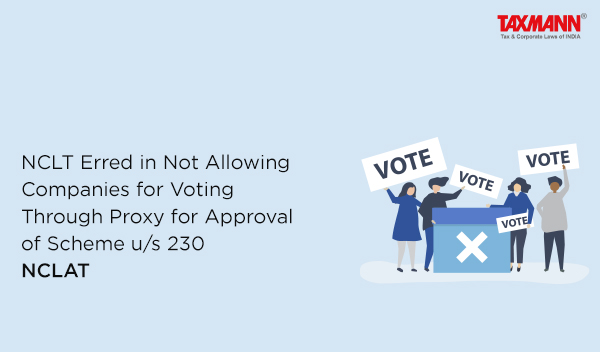NCLT Erred in Not Allowing Companies for Voting Through Proxy for Approval of Scheme u/s 230 | NCLAT
- News|Blog|Company Law|
- 2 Min Read
- By Taxmann
- |
- Last Updated on 3 October, 2023
Case Details: TCR Trading (P.) Ltd. v. Tridev Advisory Services (P.) Ltd. - [2023] 154 taxmann.com 296 (NCLAT-New Delhi)
Judiciary and Counsel Details
-
- Anant Bijay Singh, Judicial Member & Naresh Salecha, Technical Member
- Rishabh Jain, Adv. for the Appellant.
- Nikhil Verma, Adv. for the Respondent.
Facts of the Case
In the instant case, Transferor Company No. 1, was proposed to merge with another transferor Company No. 2 into the respondent (i.e. the transferee company). All three companies proposed a scheme of amalgamation to reduce expenses, bring efficient cash management and consolidation of business.
They jointly filed an application before the Tribunal seeking the dispensation of the meeting of shareholders of transferor companies and transferee companies. Additionally, they also sought approval from both unsecured and secured creditors of the transferor companies.
The Transferee Company also sought direction for convening meetings of secured and unsecured creditors, as it did not obtain NOCs from its secured and unsecured creditors.
The Adjudicating Authority (NCLT) by the impugned order directed to convene a meeting and allowed voting on the proposed scheme by voting in person but voting through proxy was not allowed. Subsequently, an appeal was made to the National Company Law Appellate Tribunal (NCLAT) against the order passed by the NCLT.
It was noted that in view of section 230(4) of the Companies Act, 2013 and Rules 9, 10 and 13 of the Companies (Compromises, Arrangements and Amalgamation) Rules, 2016, voting by proxy is allowed.
NCLAT Held
The NCLAT observed that an explanation to Rule 5(d) of the Companies (Compromises, Arrangements and Amalgamation) Rules, 2016 stated that the Chairman, inter alia shall, at the general meeting, at the end of discussions on resolutions on which voting is to be held, allow voting by the use of an electronic voting system for all those members who are present at a general meeting but have not cast their votes by availing remote e-voting facility.
The NCLAT held that the NCLT erred by not allowing voting in modes other than in-person at meetings of secured and unsecured creditors of the transferee company. Therefore, the impugned order was to be set aside.
List of Cases Reviewed
-
- Order of NCLT – Delhi in (CAA) 116/MD/2021, dated 8-12-2021 (para 13) reversed.
Disclaimer: The content/information published on the website is only for general information of the user and shall not be construed as legal advice. While the Taxmann has exercised reasonable efforts to ensure the veracity of information/content published, Taxmann shall be under no liability in any manner whatsoever for incorrect information, if any.

Taxmann Publications has a dedicated in-house Research & Editorial Team. This team consists of a team of Chartered Accountants, Company Secretaries, and Lawyers. This team works under the guidance and supervision of editor-in-chief Mr Rakesh Bhargava.
The Research and Editorial Team is responsible for developing reliable and accurate content for the readers. The team follows the six-sigma approach to achieve the benchmark of zero error in its publications and research platforms. The team ensures that the following publication guidelines are thoroughly followed while developing the content:
- The statutory material is obtained only from the authorized and reliable sources
- All the latest developments in the judicial and legislative fields are covered
- Prepare the analytical write-ups on current, controversial, and important issues to help the readers to understand the concept and its implications
- Every content published by Taxmann is complete, accurate and lucid
- All evidence-based statements are supported with proper reference to Section, Circular No., Notification No. or citations
- The golden rules of grammar, style and consistency are thoroughly followed
- Font and size that’s easy to read and remain consistent across all imprint and digital publications are applied








 CA | CS | CMA
CA | CS | CMA


